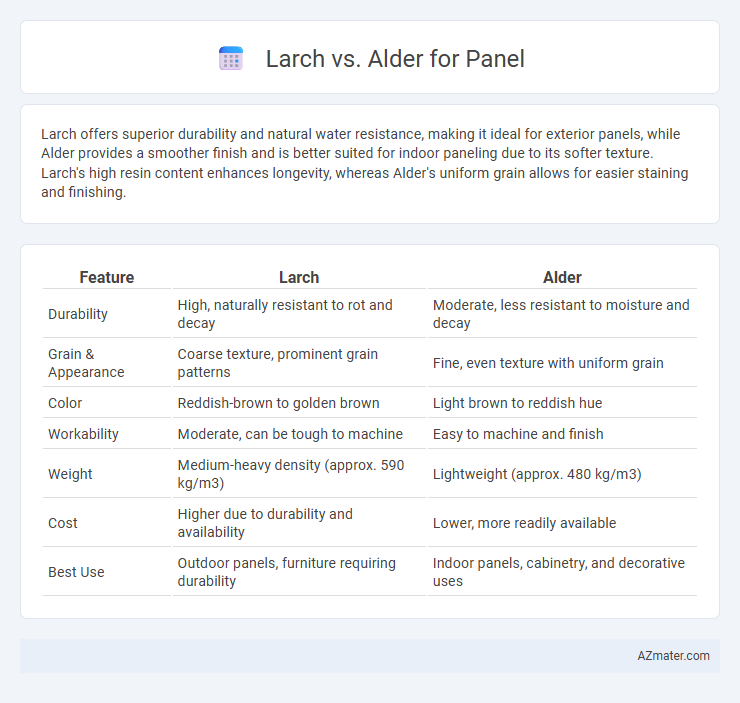Larch offers superior durability and natural water resistance, making it ideal for exterior panels, while Alder provides a smoother finish and is better suited for indoor paneling due to its softer texture. Larch's high resin content enhances longevity, whereas Alder's uniform grain allows for easier staining and finishing.
Table of Comparison
| Feature | Larch | Alder |
|---|---|---|
| Durability | High, naturally resistant to rot and decay | Moderate, less resistant to moisture and decay |
| Grain & Appearance | Coarse texture, prominent grain patterns | Fine, even texture with uniform grain |
| Color | Reddish-brown to golden brown | Light brown to reddish hue |
| Workability | Moderate, can be tough to machine | Easy to machine and finish |
| Weight | Medium-heavy density (approx. 590 kg/m3) | Lightweight (approx. 480 kg/m3) |
| Cost | Higher due to durability and availability | Lower, more readily available |
| Best Use | Outdoor panels, furniture requiring durability | Indoor panels, cabinetry, and decorative uses |
Introduction: Comparing Larch and Alder for Paneling
Larch wood is known for its durability, water resistance, and rich reddish-brown hue, making it a popular choice for exterior and interior paneling that demands longevity. Alder, in contrast, features a fine, straight grain with a smooth texture and a lighter, reddish tone, often preferred for interior panels where aesthetic warmth and ease of finishing are crucial. Comparing Larch and Alder for paneling highlights key differences in hardness, moisture resistance, and visual appeal, guiding optimal material selection based on environmental exposure and design intent.
Botanical Profiles: Larch vs Alder
Larch (Larix spp.) is a deciduous conifer known for its durable and resin-rich wood, exhibiting fine grain and high resistance to decay, making it ideal for exterior panels. Alder (Alnus spp.) is a hardwood with a smooth texture and moderate durability, characterized by its even grain and excellent workability, commonly used for interior paneling. Both species offer distinct botanical profiles where Larch's needle-like leaves contrast with Alder's broad, ovate leaves, influencing their respective timber qualities and applications.
Appearance and Grain Characteristics
Larch wood features a rich reddish-brown hue with distinctive tight, straight grain patterns that enhance panel aesthetics with a warm, natural look. Alder presents a lighter, creamy color with a relatively uniform, fine grain, offering a smoother and more consistent surface ideal for modern or minimalist panel designs. Larch's pronounced grain makes it suitable for rustic or traditional interiors, whereas alder's subtle texture supports versatility in various decorative styles.
Durability and Longevity
Larch wood exhibits superior durability and longevity compared to alder due to its dense grain structure and high resin content, which naturally protects against decay and insect damage. Alder, while easier to work with and more affordable, generally has a softer texture that makes it more susceptible to wear and moisture-related deterioration over time. Panels crafted from larch are ideal for long-lasting applications requiring resistance to harsh weather conditions and heavy use.
Workability and Ease of Installation
Larch wood offers superior workability due to its straight grain and moderate hardness, making it easier to saw, plane, and nail compared to alder. Alder panels are generally lighter and softer, which simplifies cutting and handling but can lead to quicker wear on tools and less resistance during installation. Choosing larch for paneling ensures durable, stable joints and a smoother finish, while alder provides easier customization during the installation process but may require more careful handling to avoid damage.
Resistance to Decay, Moisture, and Insects
Larch wood exhibits superior resistance to decay, moisture, and insect attacks compared to Alder, making it a preferred choice for paneling in humid or exterior environments. Its dense grain structure and high natural resin content provide enhanced durability against fungal rot and wood-boring insects. While Alder offers a smooth surface and ease of finishing, its lower resistance to moisture and decay limits its long-term performance in damp conditions.
Cost and Availability
Larch wood typically offers greater availability and moderate cost due to its widespread growth in Europe and North America, making it a preferred choice for panel applications requiring durability and water resistance. Alder, while often more affordable, has limited availability in some regions, which can affect procurement costs and timing for larger panel orders. Cost efficiency for panels depends on regional supply chains, but Larch generally balances price with strength, whereas Alder is valued for its softer texture and ease of machining in budget-sensitive projects.
Environmental Impact and Sustainability
Larch wood is prized for its durability and natural resistance to decay, contributing to longer-lasting panels and reducing the need for frequent replacements, thereby lowering resource consumption over time. Alder, a fast-growing hardwood, promotes sustainable forestry practices due to its rapid regeneration, making it an eco-friendly choice that supports carbon sequestration and biodiversity. Choosing larch or alder panels depends on balancing durability needs with the environmental benefits of faster growth cycles and sustainable forest management.
Best Use Cases: Larch vs Alder Panels
Larch panels excel in exterior applications due to their high durability, natural resistance to rot, and attractive grain, making them ideal for siding, decking, and outdoor furniture. Alder panels are preferred for interior uses, offering a smooth texture and uniform appearance, perfect for cabinetry, furniture, and decorative wall panels. Both woods provide unique benefits, with Larch favored for heavy-duty, weather-exposed projects and Alder chosen for refined interior aesthetics.
Conclusion: Choosing the Right Wood for Your Panels
Larch provides exceptional durability and natural resistance to decay, making it ideal for outdoor or high-moisture panel applications, while alder offers a smoother grain and easier workability suited for interior decorative panels. Considering factors such as environmental exposure, desired aesthetics, and budget helps determine the best wood choice. For heavy-duty, weather-resistant panels, larch is preferable, whereas alder excels in refined interior settings requiring a warm, consistent finish.

Infographic: Larch vs Alder for Panel
 azmater.com
azmater.com